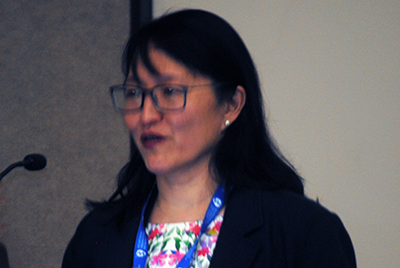Pediatric Psychosomatic Physician Talks About Special Considerations for Young, Medically Ill

Psychosomatic medicine—the psychological care of people with physical illnesses—is a relatively new medical specialty field, having been recognized only in 2003 as an official subspecialty in which psychiatrists can earn board certification. While most people think of psychosomatic medicine as a field that treats adult patients with cancer, HIV/AIDS, or other serious illnesses, there is a vibrant and emerging community of pediatric psychosomatic doctors.
One such physician, Maryland Pao, M.D. (pictured above), the clinical and deputy scientific director at the National Institute of Mental Health, put her field in the limelight at this year’s Annual Meeting with her talk “Pediatric Psychosomatic Medicine: A Field in Development.”
The last word has double meaning, for while pediatric psychosomatic medicine is still changing and evolving, it also reflects the importance of being sensitive to childhood developmental trajectories in clinical practice.
“Our job is to maximize children’s health-related quality of life, and there is a greater focus on facilitating coping and adjustment and not just assessing psychopathology,” she said. Another difference for pediatric psychosomatic specialists is that given the time course of when mental illnesses manifest, there are also more opportunities for prevention in the younger population.
Pao provided two examples of recent accomplishments that highlight some of the nuanced differences between pediatric psychosomatic medicine and the adult counterpart.
The first involved the decade-long journey of developing a screening tool for pediatric suicide. There are many templates available as a starting point, including the gold-standard Suicidal Ideation Questionnaire (SIQ), but adapting SIQ queries to children required some careful considerations.
Some issues involved simple word choice, such as whether children would understand terms like “unbearable.” There are also changes based on children’s role in family, so rather than ask about a child’s individual burden, it might be more appropriate to ask, Have you felt your family would be better off if you were dead?
After a couple iterations, Pao was glad to report that a team of which she was a part managed to find a set of four questions that could identify suicide risk in children with both psychiatric and other medical disorders in an emergency department setting. Researchers are currently validating the ask suicide-screening questions (asq) in other settings.
The other advance also deals with mortality—how to approach end-of-life questions and decision making in children with a chronic condition like cancer or a congenital heart defect. Life expectancy for children with such disorders is greatly improved, but they still claim many lives. Until recently, the issue of how children want to plan for end of life was not really considered, since legally the parents have all the rights.
But through focus groups, Pao and her colleagues found that children are very interested in their potential end-of-life choices, but more so in how they would like to be personally treated (as opposed to medically treated) and how they wanted to be remembered by family and friends.
Pao and colleagues then adapted an adult advanced care planning tool known as My Five Wishes and created another tool called voicing my choices.
“What makes this tool very powerful is that not only does it empower children and express their desires, but it also helps parents make more informed decisions on behalf of their children,” Pao said.
Pao noted another important consideration in her field is that there are special considerations in relation to children, as well as to pediatric nurses and other providers. “A lot of the subjects we deal with, like suicide and end-of-life care, are still considered taboo in some circles, so we have to make sure that the language we use can be delivered in a thoughtful and appropriate manner,” she said.
(Image: Nick Zagorski)
|
|
|
|
|


